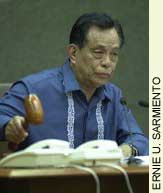

      
|
Time to go federalBy Anna YapThe idea of a federal system of government for the Philippines was first mooted in the 1970s. But it was shot down immediately. A federal system of government refers to a union of states under a central government distinct from the governments of the individual states. The state governments have more autonomy in the running of their states. In May 2000, at the height of the war between the government and the Moro rebel forces, the shift to federalism was among the proposals aired in a round-table conference of Mindanaoleaders. It received lukewarm response and was tabled for "further study." It was a "right idea but wrong timing." Fears were expressed that President Estrada might say yes but instead push for the constitutional amendments he campaigned for in 1999. In June 2000, at the height of Mr. Estrada's "all-out" war against the Moro Islamic Liberation Front, Senators Aquilino Pimentel Jr., Francisco Tatad and John Osmena proposed a shift to the federal form of government. 
Pimentel said a federal system would "provide the foundation for a just and lasting peace in central and southern Mindanao." It will also give "an equal opportunity for the development of the regions in the country to counter the perception, if not the reality, that Metro Manila is favored over other regions in matters of development," he said. However, then Sen. Raul Roco said the idea would not prosper, citing that a call for a ConCon would require a two-thirds vote of the 22-member Senate. "There are at least nine (senators who are) potentially opposed to federalism so a Constitutional Convention can't be held anymore," he said. Mr. Estrada shot down the proposal for a ConCon. He said he had more pressing matters to attend than toy around with federalism and that Congress had more important bills to tackle. Shifting from a presidential system to a federal type requires amending the Constitution. Since 1997, efforts to rewrite the Charter (then Pres. Fidel V. Ramos' Cha-Cha and Pres. Estrada's Concord) were blocked by people's organizations because of the nature of the proposed amendments. Pimentel said the "hardest obstacle" was the revision of the Constitution."People are wary of attempts to amend or revise the Constitution. Thus, it is safe to assume that even if we were able to get the Senate to agree to push for the adoption of a federal form of government, it will take a long time before that can realistically be achieved," he said. In October 2000, the Juetengate broke out. That same day, an invitation was sent out for the launching of the Federal Movement of the Philippines in Cebu on Nov. 18. The event was postponed because the proponents, including Pimentel, were busy with the president's impeachment trial. The invitation came with a "tentative proposal" to create 10 federal states (four in Luzon, three each in the Visayas and Mindanao) and one federal administrative center. The proposed federal states are Northern Luzon, Central Luzon, Southern Tagalog, Bicol, Eastern Visayas, Central Visayas, Western Visayas, Northern Mindanao, Northeastern Mindanao and Bangsamoro. The conference took place on Nov. 27 in Davao City. It began with a question mark: "Federalism: An idea whose time has come?" When it ended at noon the next day, the mark on the huge backdrop was replaced by an exclamation point. With the impeachment of the president, the calls for his resignation and the people's clamor for substantive change, participants to the Davao City conference said the long-time solution for the problems plaguing the country was to go federal. This would reduce opportunities for corruption and make government more responsive to the clamor for power sharing and equitable distribution of wealth and resources, said the participants. Historian Datu Michael Mastura, a participant, volunteered to help draft the proposal for a model Constitution of the Federal Republic of the Philippines. 
If we can package the federal setup," he said, "this can be the best compromise that would address the problems in the country, including the Bangsamoro. The aspirations of the lumad (indigeneous tribes) and the Moro would have more chances of realization under a federal system." In Jan. 2001, Mr Estrada was ousted by the people and Vice Pres. Gloria Macapagal-Arroyo took his place. In view of the problems faced by the country, the time, indeed, has come to go federal.(Source: Philippine Daily Inquirer, 12/3/2000). Your comment will be most welcome on this article. Won't you take a moment to let me hear from you? |
|
|
Students of Journalism 196-2 2nd Semester, SY 2001-2002 College of Mass Communication University of the Philippines Diliman, Quezon City, 1101 PHILIPPINES e-mail to: bungang_arao@yahoo.com | nbsp; | |